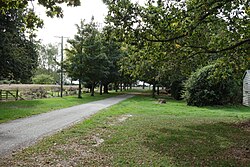Barrhill, New Zealand
| Barrhill | |
|---|---|
| Village | |

View along Sycamore Avenue in Barrhill
|
|
| Barrhill | |
| Coordinates: 43°40′22.8″S 171°51′10.8″E / 43.673000°S 171.853000°ECoordinates: 43°40′22.8″S 171°51′10.8″E / 43.673000°S 171.853000°E | |
| Country | New Zealand |
| Region | Canterbury |
| Territorial authority | Ashburton District |
| Founded | 1876 |
| Founded by | Cathcart Wason |
| Named for | Barrhill, South Ayrshire |
| Area | |
| • Total | 36 km2 (14 sq mi) |
| • Land | 31 km2 (12 sq mi) |
| • Water | 5 km2 (2 sq mi) |
| Elevation | 210 m (690 ft) |
| Population (2013 census) meshblock 2750400 | |
| • Total | 66 |
| • Density | 1.8/km2 (4.7/sq mi) |
Barrhill is a lightly populated locality in the Canterbury region of New Zealand's South Island. It is situated on the Canterbury Plains, on the right bank of the Rakaia River, about 17 kilometres (11 mi) inland from Rakaia. It was founded by Cathcart Wason in the mid-1870s and named by him after his old home Barrhill in South Ayrshire, Scotland. Wason set it up as a model village for the workers of his large sheep farm. The population of the village peaked in the mid-1880s before the general recession initiated a downturn for the village. Wason had expected for the Methven Branch railway to run past Barrhill, but the line was built in 1880 on an alignment many miles away, which caused Barrhill population to decrease.
Three of the original buildings of Barrhill plus the gatehouse at Wason's homestead were constructed of concrete, and they still exist to this day. One of those buildings, St John's Church, is registered by Heritage New Zealand as a Category II heritage building, and the gatehouse is a museum that is open on request. Today, few buildings exist in the village, but the formal layout of avenues still exists, giving the setting a charming appearance.
Barrhill is a small settlement between the Rakaia Barrhill Methven Road and the Rakaia River, located 210 metres (690 ft) above sea level. It is about 17 kilometres (11 mi) from the town of Rakaia and 21 kilometres (13 mi) from Methven. The four outer streets, one of which is the Rakaia Barrhill Methven Road, form a trapezoid with the longest side at 200 metres (660 ft). Two internal roads run at right angles to one another, dividing the area into four quadrants. The intersection of the internal roads forms the market place.
Apart from the main road, there are five avenues, each planted in its own species and named accordingly: oak, poplar, birch, lime, and sycamore. The tree-lined avenues give Barrhill a charming appearance. Wason had trees planted in an unusual pattern around the market square. Residents only noticed in 1975 when viewing an aerial photo that those trees form what appears to be the three circles of Trinity, with the two inner avenues possibly symbolising a crucifix.
...
Wikipedia

